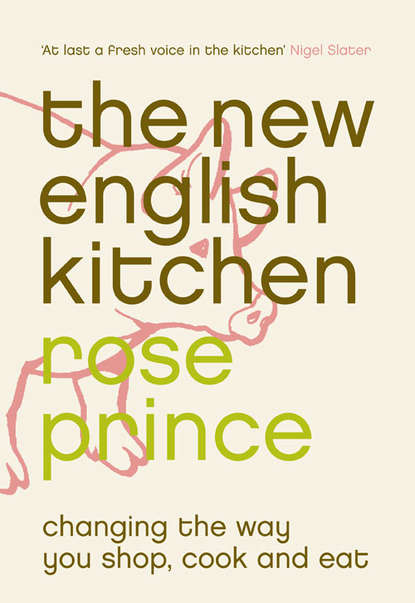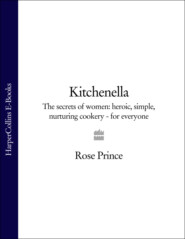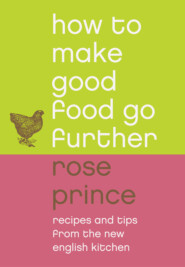По всем вопросам обращайтесь на: info@litportal.ru
(©) 2003-2024.
✖
The New English Kitchen: Changing the Way You Shop, Cook and Eat
Настройки чтения
Размер шрифта
Высота строк
Поля
If the essence of this book is to know the value of food and make the most of it, then bread is the currency. Bread is money. It is slang for money and when you’re on the breadline you have run out money. Two bestselling books that differ in their account of the value of bread wryly tickle. In Angela’s Ashes, by Frank McCourt (Flamingo, 1996), a poverty-stricken boy glimpses through a Limerick window a piece of bread spread with jam. His mouth-watering description of it is enough to prove that even at a young age he knows the value of bread. The other book, Dr Atkins’ New Diet Revolution (Vermilion, 1999), advises avoiding bread – or carbohydrates. Dr Atkins says that mixing carbs with protein, or meat, makes us obese – and so bread must be banished. It goes without saying that Dr Atkins’ book is not a bestseller in the developing world. It walks off the shelves in Britain and America, however, because most of these countries’ inhabitants are rich enough not to need bread.
the giant bread machine
‘All our bakers are master bakers,’ the factory manager told me. At that moment a master baker, dressed in regulation cover-up clothing, pushed a button and the bread production line swung into action.
Real master bakers are trained to use their hands to judge the texture of the dough, feeling its elasticity and warmth. They learn their trade in high-street bakeries or medium-sized bread wholesalers, where the bread is made at night. After leaving school, I worked as a shop assistant in a traditional bakery for nearly two years. The baker arrived at one in the morning to start the baking and clocked off at 8 a.m., half an hour after we turned the door sign to read ‘open’. The hardship of beginning work at 7 a.m. was tempered by that gorgeous smell of bread emerging from the oven. As I walked to the bakery in the dark early morning, the aroma grew gradually more powerful until I was close enough to see a spectre of steam puffing out of the basement. The baker, Steve, who had spent time ‘inside’ after a fight, controlled his aggression with an interest in martial arts. But he also loved to bake. He liked the science and enjoyed using his skill – judging the readiness of the dough at every stage, shaping it by hand, and baking it in a century-old brick oven. He even liked to be up at night working while everyone else slept. His hours were strictly controlled by his trade union, in spite of his lonely job. Any slight alteration to the weekly timetable was subject to intense negotiation: well-muscled Steve versus a skinny shop manager, hell bent on not provoking the baker to lose his temper.
In the Midlands factory I visited many years later, the bakers use their hands only to push buttons during their eight-hour shift. This bread is made via the Chorleywood Process, the revolutionary high-speed mechanical baking system invented in 1961. The factory never rests, baking around the clock. It takes just one and three-quarter hours for a loaf to make its journey along the production line, helped by extra yeast and water and high-speed mixers. It is necessary to add flour ‘improvers’, usually in the form of soya flour, to ensure that the bread will literally rise to the occasion in such an artificially short space of time. Enzyme processing aids, softening agents, sugars, fats and preservatives are also sometimes added. These ingredients combine to speed up the natural breadmaking process, resulting in a soft, sweetish loaf with a long shelf life, which fits neatly into the modern maxim that shopping should happen just once a week.
And where do you, the consumer, fit in? The bread factories would say that all this is done for your benefit. This is the bread you want, and indeed for many, soft, sweet bread is easy to like; children in particular are swiftly seduced.
The high-tech mechanisation of bread comes at the cost of its integrity, however. Compare factory-produced bread to Italian dried durum wheat pasta, most of which is now made speedily in giant factories. The mixing is done high in their ceilings, the dough passes through giant tubes, is pressed through the various dies that make the shapes and then travels into vast drying machines that imitate the Neapolitan sun and sea breezes. But it still contains just flour and water. Pasta is perfect for mechanisation – the food itself never loses its integrity. Bread, on the other hand, needs a whole lot of help by way of additives if it is to survive the Chorleywood palaver.
bread in society
When I criticised sliced and wrapped bread in a newspaper for the first time, it provoked a reaction from the industry that both surprised and annoyed me. Their letters of complaint did not exactly defend their process; instead, they justified it by saying that it ‘allowed everyone to eat cheap white bread’. This polemic takes us back over 140 years, when refined white bread had status. The upper classes ate white bread, the poor could afford only the rough, wholegrain type. Flour was ground between stones and then painstakingly sifted to remove the wheatgerm, leaving the flour pure and white – an expensive process.
Then roller mills were invented and suddenly white flour was cheaper to produce. The china rollers removed the brown (good) bits in the flour efficiently. This flour was the forerunner of our modern sliced and wrapped bread. It did indeed give cheap white bread to the poor, but I find it sickening that the modern industry is still arguing that this is the point of high-speed mechanisation. I believe that what it is really saying is: ‘You’re poor, so you get bread with additives, too much yeast, and no flavour; its integral goodness has been milled out, artificial vitamins have been added to replace it – but you can lump it because you are eating white bread, you lucky people.’
Food snobbery is alive and well, sadly. And highly divisive. There is still one form of nutrition for one group in society and one for another. What can you say in a country that still has two different words for the meal eaten in the middle of the day?
Mechanised breadmaking is no longer about feeding everyone white bread; it is about profit. It is about producing more for less, faster – and to hell with breadmaking tradition. But breadmaking, just like winemaking or rearing a beef steer naturally, is a slow process that yields results that are worth the wait. The recipes in this chapter help to solve the problem of how to afford good bread. They show that bread can be made inexpensively and retain its integrity, and they also show how to use every last crumb. This is bread for all.
how to recognise good bread
There has been a definite surge of interest in handmade or craft bread. This is bread made in the traditional way with two fermentations, during which time it builds true flavour. Good flour is essential. Bread made from stoneground flour retains wheatgerm, even if the ‘brown’ has been sifted out. Some bakers are interested again in good flour, in the slower baking process and also in traditional ovens – there are now commercial bakeries with domed brick ovens, offering all kinds of loaves made from a wide variety of grains.
When you buy bread, take a good look at it. The crust should not be too thick but its outer veneer should be brittle and crisp. The shape should be as the baker intended – bread that has been hurried will have a lopsided appearance where the interior has risen too fast, breaking through the crust. Smell the bread, too. The aroma of new baking should cling to a fresh loaf. Once it begins to fade, your bread is ready to use for toast or in recipes.
Feel the bread. The interior crumb should have elasticity, tearing when pulled rather than breaking. Despite its bubbly appearance, it should feel heavy for its size. Compare the weight of a piece of factory-produced sliced bread to a similar-sized slice of bread made with stoneground flour at traditional speed. Dry, crumbly bread has either been incorrectly made or is no longer fresh.
Finally, when you taste the bread, you should be able to detect the flavour of the grain. Even in white bread, if the flour is stoneground the flavour will be enhanced by traces of the oils that remain in it, and which are diminished in ordinary, roller-milled flour. Good bread will also taste ripe, indicating that it has been given a good long time to rise. This is most pronounced in sourdough bread, which undergoes a lengthy fermentation.
where to buy bread
Craft bakeries – Independent small bakers making bread using traditional techniques are still few in number but well worth seeking out. Don’t forget that bread freezes very well, so a journey to buy good bread is a worthwhile mission. Keep an eye on the food media – magazines, weekend newspapers, local press – for new bakery businesses starting up and give them a try.
High-street bakery chains – Home to the ubiquitous jam doughnut and bizarrely decorated buns and biscuits, the chains on the high street vary immensely but I have bought excellent bread from some of these shops. They can be a source of good everyday bread sold in whole loaves that can be sliced and bagged the moment you buy – a preferable alternative to ready sliced and wrapped.
Farmers’ markets and other specialist food markets – Worth visiting for good bakery stalls.
Urban local shops and delis – Many corner shops now sell French-style baguettes and loaves ‘baked on the premises’. The dough is made elsewhere, though, and the lack of labelling leaves you wondering how. But these Continental loaves often contain an element of authentic sourness, and I’d choose them over sliced and wrapped any day.
Food chains and smaller supermarket chains – Shops such as Marks & Spencer, Waitrose and some Spar stores have responded to the demand for craft-made breads. While never as good as true artisan-made bread, because they are produced in considerable quantities, there are some imaginatively made loaves with plenty of flavour and a good crust.
Supermarkets – The vast majority of bread sold in the Big Four supermarket chains (Asda, Morrison, Sainsbury’s and Tesco) is sliced and wrapped but again they are making inroads to supplying traditional-style bread and flour and need your encouragement. Your questions and demands concerning bread and flour will be heard. Vote, as always, for good food with the power that your own money holds. Choosing craft bread over sliced and wrapped will send messages to the industry that it has no choice but to absorb.
organic bread and good flour
Many new craft bakers use organic flours milled with wheat that has been grown naturally. Organic grain farmers are permitted to use a very few fertilisers and pesticides that are deemed safe, but this is often criticised by the conventional food industry. However, it is undeniable that traditionally made bread using organic flour tastes wonderful. The technique is partly responsible for the flavour, but with organic flour the species of wheat also has an impact.
Organic farmers tend to use traditional grain varieties that are slow to grow but are more resistant to pests and disease. Some claim that the good health of the soil has an impact on the flavour of food. This makes sense, but the organic sector would be the first to say that more research is needed into the flavour and vitality of organic food. Independent research needs Treasury money – something that has not exactly been forthcoming since the popularity of organic food has quadrupled in recent times.
All craft bakers are interested in the flour they use because flour is bread’s personality, its character. A craft baker will seek out good-quality flour, which may or may not be organic, for the greater good of the bread they bake. There is one simple way to find out – ask them. Good food producers love to talk about the food they make.
making bread at home
I make bread twice a week in a food mixer with an attached dough hook. Each batch of two loaves takes ten minutes to mix and knead. Two hours later I shape it, and about an hour later the bread is baked. There is very little physical work – bread needs your presence more than anything else. People who go out to work will find breadmaking machines useful. Alternatively you can make the dough in a mixer, put it in the fridge for the day and shape and bake it when you get home.
hands versus machine
Making bread by hand is a real pleasure, but you will need to set aside a good 15 minutes to knead the dough. Food mixers make smooth, elastic dough. I have a KitchenAid but have also used a Kenwood mixer in the past. Use mixers fitted with a dough hook on a low setting.
Busy people swear by their bread machines. They can do the whole job for you, or be set to stop when the dough is ready so it can be shaped and cooked in a conventional oven. Beware of the manufacturer’s recipe books. Some of them include recipes that are simply aping the factory process, with too much yeast and milk powder so the bread will be big and soft. Use traditional recipes instead, using the quantities given in the manufacturer’s recipe book as a guide, and you will be very pleased with what a bread machine can do.
kitchen note
Look for used Kenwood mixers in local papers and car boot sales – a heavy old one with a good motor will go on for years.
the cost of bread
At the time of writing, I buy flour in bulk and it costs me approximately 50 pence to make a loaf, plus negligible costs for yeast, oil and oven power. A loose calculation based on baking four good-quality loaves a week shows that I can save up to £312 a year on buying bread of comparable quality – money for treats.
buying flour
I used to be hopeless at making scones. When I worked at the bakery, we threw away more scones than we sold because they were always dry, weighty and crumbly. Twenty years later I nibbled a sample scone from a stall at a farmers’ market. Light and chewy, without a hint of dryness, this was the scone we were never able to make in the bakery. The stall-holder, slightly taken aback by the passionate interrogation I inflicted on her, casually remarked, ‘Oh, it’s the flour.’ She bought her flour from Cann Mills, a local water mill in Dorset. She did not know why it was so good, it just was.
I wanted to know more, so I visited the mill. The miller, Michael Stoate, took up the story of good wheat flour, the type most commonly used for making bread, scones and cakes. The modern milling industry rolls the grain to remove the bran, taking out the wheatgerm and the flour’s natural oil as it does so. This also removes a vital source of vitamins, which means that they have to be added back to the flour artificially. The wheatgerm oil is very valuable to the pharmaceutical industry, which puts it into creams to go on the outside of our bodies – oh, the irony of it. What’s more, commercial bakers need not mention that it is missing from the flour. About 70 per cent of the bread bought in the UK is made from roller-milled white flour. That is a scandalous amount of missing wheatgerm from what most of us presume is a wholefood.
Stoneground flour, whether white or brown, still contains the wheatgerm – the white flour is simply sifted to remove the bran. Michael Stoate uses millstones to grind all his flour, including the white flour that was used in those scones, with their delightful texture. Traditionally milled stoneground flour can be bought direct from mills, and in some cases delivered to your home (see the Shopping Guide). Look also in specialist independent food shops, farm shops or farmers’ markets, and on the internet. Some supermarkets stock British flour from traditional mills, but do check the label carefully.
Store flour in a sealed bin to keep out pests, or buy it in smaller bulk bags of about 5 kilos that can be sealed between use.
Bread baked in tins or shaped into high rounds needs strong flour, made from ‘hard’ wheat species. These contain a greater amount of glutenin and gliadin, essential for the bread to rise well and form a nice, elastic crumb. In the past, hard wheat was grown mainly in North America for the British bread industry, but with selective breeding it has been adapted over the last few decades to grow well in British conditions. Do not confuse strong flour with hard durum wheat flour, or semolina, which is used specifically for pasta making.
Soft wheat flour, sold as plain flour, is suitable for cake and pastry making and can also be used for soda bread and scones.
other types of flour
While the gluten in wheat flour is vital for the standard bread recipe, a percentage of another type of cereal flour can be added for variety, such as rye, barley, buckwheat or oats. These cereals, however, contain little gluten, and yeast bread made with rye, barley or oat flour alone will be heavy, and does not keep well. Alternative types of flour, made from vegetables like chick peas or potato, are more useful in other forms of cookery. There are recipes using these flours (here (#u561f8edc-08aa-4038-8020-ce6a914162b0).
yeast
Fast-action, or easy-blend, yeast is now the most widely available type. It can be mixed straight into the flour, speeding up breadmaking by about half an hour. Conventional dried yeast, sold loose in tins, should be used in the same quantity but must be dissolved in warm water first. Compressed or fresh yeast is not always easy to find now. The best places to try are independent bakeries and some health-food shops. It should be dissolved in warm water or milk before adding it to the dry ingredients. If substituting fresh yeast for dried, you will need double the quantity stated in the recipe.
a little bread science
The breadmaking process is easier to understand once you know a little piece of molecular chemistry. Yeast gives dough its oomph, but it needs gluten to do so. Live yeast makes bubbles of carbon dioxide in the soft, elastic dough. The legend of the first yeast goes that a cook left a piece of dough near a vat of beer and some of the wild yeasts from the ale got into the dough. The cook noticed the bubbles in the bread – the rest is history.









